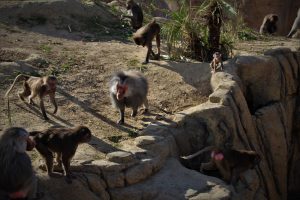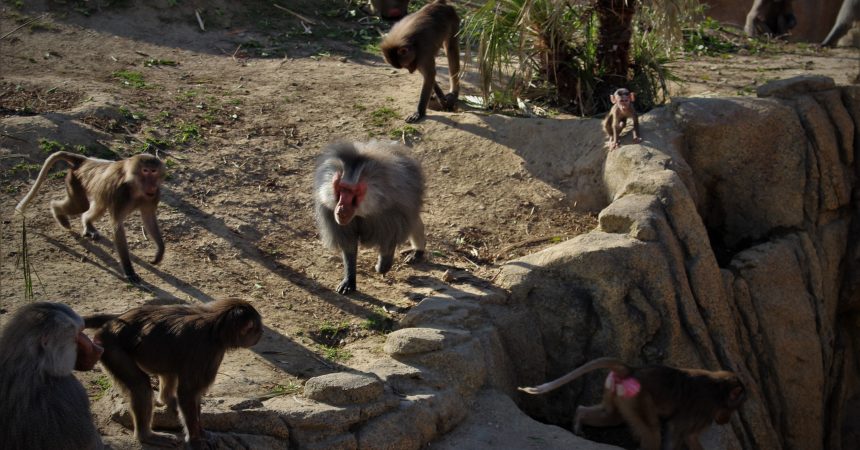Zoo InternQuest is a seven-week career exploration program for San Diego County high school juniors and seniors. Students have the unique opportunity to meet professionals working for the San Diego Zoo, Safari Park, and Institute for Conservation Research, learn about their jobs, and then blog about their experience online. Follow their adventure here on the Zoo’s website!
 In a few months’ time, the San Diego Zoo will celebrate the anniversary since the Zoo got a troop of Hamadryas baboons. The Zoo received the 20 primates from the Frankfurt Zoo in Germany. In their new enclosure, which is a part of the Africa Rocks exhibit, the baboons get to climb on rocks and trees, play in the dirt and grass, and patrol their territory on family walks. Our presenter, Dustin Black, knew that he was up for a challenge when he volunteered to be the baboons’ keeper. Although, he has over twenty years of experience zoo keeping, taking care of elephants, giraffes and other primates, he had never had extended experience working with baboons, and certainly not twenty of them.
In a few months’ time, the San Diego Zoo will celebrate the anniversary since the Zoo got a troop of Hamadryas baboons. The Zoo received the 20 primates from the Frankfurt Zoo in Germany. In their new enclosure, which is a part of the Africa Rocks exhibit, the baboons get to climb on rocks and trees, play in the dirt and grass, and patrol their territory on family walks. Our presenter, Dustin Black, knew that he was up for a challenge when he volunteered to be the baboons’ keeper. Although, he has over twenty years of experience zoo keeping, taking care of elephants, giraffes and other primates, he had never had extended experience working with baboons, and certainly not twenty of them.
The baboons’ first few months were just as much of a learning experience for them as it was for Mr. Black. The troop of primates had to be trained to shift into separate corridors, which allows for keepers to give individualized care, medication, treats, etc., to each animal. Mr. Black had to learn what would motivate the baboons to get into their separate enclosures, as well as each animal’s temperament, diet preferences and any other individual needs. Luckily, baboons quite intelligent primates, so training them did not prove to be too difficult of a challenge.
Compared to other species of primates, hamadryas baboons are considered to be of “least concern,” so in the wild their populations are stable, and in some places, growing. Mr. Black attributed their conservation status to the fact that their natural habitat is in the desert. Since they do live in the desert, there is really no danger of people destroying their homes to develop agriculture or in search of resources. Nevertheless, it is still important that the Zoo conserves and protects these animals in case of some unforeseen circumstance should cause the baboons to become endangered.
In the United States, there are 88 hamadryas baboons, so the troop in San Diego accounts for a quarter of the population. To keep families healthy, one of the conservation measures that the Zoo will be taking on is to share baboons with other zoos around the country. This helps to keep the troops genetically diverse and prevent any genetic mutations that may occur from inbreeding. Indeed, the Zoo’s adoption of the troop is another major example of conservation. The baboons have all been born in managed care, and the enclosure where they had lived was all concrete. They now live in a spacious, open air enclosure where they had plenty of room to run and play.
Keepers play an important role in the conservation of all the species at the Zoo. They work the closest with the animals, spending nearly every day with them. Since they are able to observe the normal behavior, keepers are usually the first person to notice a change in an animal’s mannerisms that indicate that something is wrong. Mr. Black shared an example of the personal relationship that the keepers form: after working with the baboons for a few months, the keepers began giving them all names. The oldest female was named “Brittney.” For several weeks, Mr. Black would greet her with a “Hi Brittney!” until one day she grunted in return. Grunting is the method of communication amongst baboons; Brittney’s grunt showed that she recognized Mr. Black, and considered him as one of her own.
The Hamadryas baboon is an example of how a species does not need to be endangered in order to be conserved. It is always important to keep in mind that we, as human beings and residents of the earth, need to be sustainable members and stewards of the environment. As evidenced by Brittney and Mr. Black’s story, there are species of animals that are intelligent enough to be capable of developing personal relationships, and it is our responsibility to conserve them. We need to do what we can to learn about species so that we can protect and preserve them for out posterity.
James, Conservation Team
Week Three, Winter Session 2018


